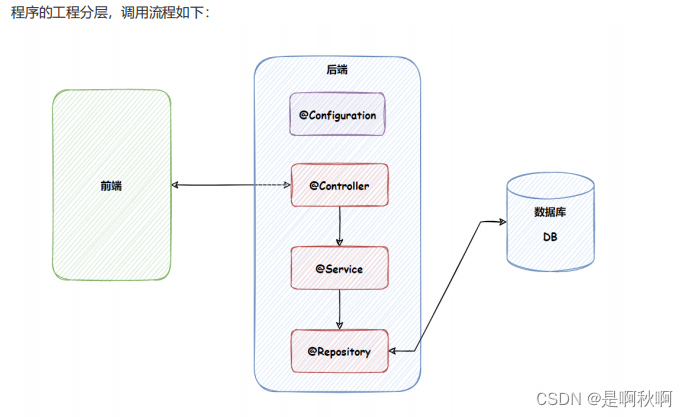Spring
目录
1.什么是Spring?
我们通常所说的 Spring 指的是 Spring Framework(Spring 框架),它是一个开源框架,有着活跃而庞大的社区,这就是它之所以能长久不衰的原因。Spring 支持广泛的应用场景,它可以让 Java 企业级的应用程序开发起来更简单。
用一句话概括 Spring:Spring 是包含了众多工具方法的 IoC 容器。
1.1 什么是容器?
1.2 什么是IoC?
1.2.1 传统模式开发

默认汽车构造类
public class NewCarExample {
public static void main(String[] args) {
Car car = new Car(); car.init(); }
/*** 汽车对象 */
static class Car {
public void init() {
// 依赖车身
Framework framework = new Framework();
framework.init();
}
}
/*** 车身类 */
static class Framework {
public void init() {
// 依赖底盘
Bottom bottom = new Bottom();
bottom.init();
}
}
/*** 底盘类 */
static class Bottom {
public void init() {
// 依赖轮胎
Tire tire = new Tire();
tire.init();
}
}
/*** 轮胎类 */
static class Tire {
// 尺寸
private int size = 30;
public void init() {
System.out.println("轮胎尺寸:" + size);
}
}
}修改尺寸后
public class NewCarUpdateExample {
public static void main(String[] args) {
Car car = new Car(20);
car.run();
}
/*** 汽车对象 */
static class Car {
private Framework framework;
public Car(int size) {
framework = new Framework(size);
}
public void run() {
// 依赖车身
framework.init();
}
}
/*** 车身类 */
static class Framework {
private Bottom bottom;
public Framework(int size) {
bottom = new Bottom(size);
}
public void init() {
// 依赖底盘
bottom.init();
}
}
/*** 底盘类 */
static class Bottom {
private Tire tire;
public Bottom(int size) {
tire = new Tire(size);
}
public void init() {
// 依赖轮胎
tire.init();
}
}
/*** 轮胎类 */
static class Tire {
// 尺寸
private int size;
public Tire(int size) {
this.size = size;
}
public void init() {
System.out.println("轮胎尺寸:" + size);
}
}
}如何解决?
我们可以尝试不在每个类中自己创建下级类,如果自己创建下级类就会出现当下级类发生改变操作,自 己也要跟着修改。
此时,我们只需要将原来由自己创建的下级类,改为传递的方式(也就是注入的方式),因为我们不需 要在当前类中创建下级类了,所以下级类即使发生变化(创建或减少参数),当前类本身也无需修改任何代码,这样就完成了程序的解耦。
1.2.2 控制反转开发

基于以上思路,我们把调用汽车的程序示例改造一下,把创建子类的方式,改为注入传递的方式,具体实现代码如下
package demo;
/**
* @author 是阿秋啊
* @date 2022/09/27 13:11
**/
public class IocCarExample {
public static void main(String[] args) {
Tire tire = new Tire(20);
Bottom bottom = new Bottom(tire);
Framework framework = new Framework(bottom);
Car car = new Car(framework);
car.run();
}
static class Car {
private Framework framework;
public Car(Framework framework) {
this.framework = framework;
}
public void run() {
framework.init();
}
}
static class Framework {
private Bottom bottom;
public Framework(Bottom bottom) {
this.bottom = bottom;
}
public void init() {
bottom.init();
}
}
static class Bottom {
private Tire tire;
public Bottom(Tire tire) {
this.tire = tire;
}
public void init() {
tire.init();
}
}
static class Tire {
private int size;
public Tire(int size) {
this.size = size;
}
public void init() {
System.out.println("轮胎:" + size);
}
}
}此时,底层类无论如何变化,整个调用连都不会做任何改变,这样就完成了代码之间的解耦,从而实现了更加灵活、通用的程序设计了
1.2.3 总结对比
在传统的代码中对象创建顺序是:Car -> Framework -> Bottom -> Tire
改进之后解耦的代码的对象创建顺序是:Tire -> Bottom -> Framework -> Car
通用程序的实现代码,类的创建顺序是反的传统代码是Car控制并创建Framework,Framework 创建并创建了Bottom,依次往下,而改进之后的控制权发生的反转,不再是上级对象创建并控制下级对象了,而是下级对象把注入将当前对象中,下级的控制权不再由上级类控制了,这样即使下级类发生任何改变,当前类都是不受影响的,这就是典型的控制反转,也就是 IoC 的实现思想。
1.3 Spring IoC
既然 Spring 是一个 IoC(控制反转)容器,重点还在“容器”二字上,那么它就具备两个最基础的功能: 将对象存入到容器; 从容器中取出对象。
学Spring 最核心的功能,就是学如何将对象存入到 Spring 中,再从 Spring 中获取对象的过程。
将对象存放到容器中的好处:将对象存储在 IoC 容器相当于将以后可能用的所有工具制作好都放到仓库中,需要的时候直接取就行了,用完再把它放回到仓库。而 new 对象的方式相当于,每次需要工具了,才现做,用完就扔掉了也不会保存,下次再用的时候还得重新做,这就是 IoC 容器和普通程序开发的区别。
Spring 是一个 IoC 容器,说的是对象的创建和销毁的权利都交给 Spring 来管理了,它本身又具备了存 储对象和获取对象的能力。
2.Spring项目的创建和使用

2.1创建Spring项目
使用 Maven 方式来创建一个 Spring 项目,创建 Spring 项目和 Servlet 类似,总共分为以下 3 步:
<dependencies>
<dependency>
<groupId>org.springframework</groupId>
<artifactId>spring-context</artifactId>
<version>5.2.3.RELEASE</version>
</dependency>
<dependency>
<groupId>org.springframework</groupId>
<artifactId>spring-beans</artifactId>
<version>5.2.3.RELEASE</version>
</dependency>
</dependencies>最后在创建好的项目 java 文件夹下创建一个启动类,包含 main 方法即可:
2.2 存储Bean对象
1.创建Bean; 所谓的 Bean 就是 Java 语言中的一个普通对象
public class User {
public String sayHi(String name) {
return name + " hello!";
}
}2.将Bean注册到容器中

<?xml version="1.0" encoding="UTF-8"?>
<beans xmlns="http://www.springframework.org/schema/beans"
xmlns:xsi="http://www.w3.org/2001/XMLSchema-instance"
xsi:schemaLocation="http://www.springframework.org/schema/beans http://www.springframework.org/schema/beans/spring-beans.xsd">
</beans>再将 User 对象注册到 Spring 中就可以
<beans>
<bean id="user" class="com.bit.User"></bean>
</beans>2.3获取并使用Bean对象
1. 创建 Spring 上下文
Spring 上下文对象可使用 ApplicationContext:
// 1.得到 Spring 的上下文对象,创建的时候需要配置 Spring 配置信息
ApplicationContext context = new ClassPathXmlApplicationContext("spring- config.xml");BeanFactory beanFactory = new XmlBeanFactory(new ClassPathResource("spring- config.xml"));ApplicationContext VS BeanFactory的区别如下 :继承关系和功能方面来说:Spring 容器有两个顶级的接口:BeanFactory和
ApplicationContext 。其中 BeanFactory 提供了基础的访问容器的能力, ApplicationContext属于 BeanFactory 的子类,它除了继承了 BeanFactory 的所有功能之外,它还拥有独特的特性, 还添加了对国际化支持、资源访问支持、以及事件传播等方面的支持。从性能方面来说:ApplicationContext 是一次性加载并初始化所有的 Bean 对象,而 BeanFactory 是需要那个才去加载那个,因此更加轻量。
2.获取Bean对象
// 1.得到 Spring 上下文对象
ApplicationContext context = new ClassPathXmlApplicationContext("spring- config.xml");
// 2.加载某个bean
User user = (User) context.getBean("user");需要注意id要一一对应

getBean()方法的更多用法:getBean() 方法有很多种重载方法,我们也可以使用其他方式来获取 Bean 对象,比如以下这两种:
根据类型获取 Bean:UserController user = context.getBean(UserController.class);
名称 + 类型获取 Bean:UserController user = context.getBean("user", UserController.class);
二者的区别:当有一个类型被重复注册到 spring-config.xml 中时,只能使用根据名称获取了。
3. Bean的使用
拿到Bean之后,就可以调用Bean对象中的方法
public class App {
public static void main(String[] args) {
// 1.得到 Spring 上下文对象
ApplicationContext context = new ClassPathXmlApplicationContext("spring-config.xml");
// 2.加载某个 bean
User user = (User) context.getBean("user");
// 3.调用相应的方法
System.out.println(user.sayHi("Java"));
}
}2.4 Bean对象的注解存储
要用注解存储Bean,需要先进行配置文件
<?xml version="1.0" encoding="UTF-8"?>
<beans xmlns="http://www.springframework.org/schema/beans"
xmlns:xsi="http://www.w3.org/2001/XMLSchema-instance"
xmlns:content="http://www.springframework.org/schema/context"
xsi:schemaLocation="http://www.springframework.org/schema/beans http://www.springframework.org/schema/beans/spring-beans.xsd http://www.springframework.org/schema/context https://www.springframework.org/schema/context/spring-context.xsd">
<content:component-scan base-package="com.bit.service"></content:component-scan>
</beans>
添加注解存储 Bean 对象
在 Spring 中,有两种注解类型可以实现:

@Controller // 将对象存储到 Spring 中
public class UserController {
public void sayHi(String name) {
System.out.println("Hi," + name);
}
}public class Application {
public static void main(String[] args) {
// 1.得到 spring 上下文
ApplicationContext context = new ClassPathXmlApplicationContext("spring-config.xml");
// 2.得到 bean
UserController userController = (UserController) context.getBean("userController");
// 3.调用 bean 方法
userController.sayHi("Bit");
}
}
3.方法注解 @Bean
@Component
public class Users {
@Bean
public User user1() {
User user = new User();
user.setId(1);
user.setName("Java");
return user;
}
}2.4 对象注入(对象装配)
对象装配(对象注入)的实现方法以下 3 种:
@Autowired
@Controller
public class UserController {
// 注入方法1:属性注入
@Autowired
private UserService userService;
public User getUser(Integer id) {
return userService.getUser(id);
}
}@Controller
public class UserController2 {
// 注入方法2:构造方法注入
private UserService userService;
@Autowired
public UserController2(UserService userService) {
this.userService = userService;
}
public User getUser(Integer id) {
return userService.getUser(id);
}
}注意事项:如果类只有一个构造方法,那么 @Autowired 注解可以省略;如果类中有多个构造方法,那么需要添加上 @Autowired 来明确指定到底使用哪个构造方法。
@Controller
public class UserController3 {
// 注入方法3:Setter注入
private UserService userService;
@Autowired
public void setUserService(UserService userService) {
this.userService = userService;
}
public User getUser(Integer id) {
return userService.getUser(id);
}
}三种注入方式优缺点分析
属性注入的优点是简洁,使用方便;缺点是只能用于 IoC 容器,如果是非 IoC 容器不可用,并且只有在使用的时候才会出现 NPE(空指针异常)。
构造方法注入是 Spring 推荐的注入方式,它的缺点是如果有多个注入会显得比较臃肿,但出现这种情况你应该考虑一下当前类是否符合程序的单一职责的设计模式了,它的优点是通用性,在使用之前一定能把保证注入的类不为空。
Setter 方式是 Spring 前期版本推荐的注入方式,但通用性不如构造方法,所有 Spring 现版本已经推荐使用构造方法注入的方式来进行类注入了。
@Resource:另一种注入关键字
@Controller
public class UserController {
// 注入 @Resource
private UserService userService;
public User getUser(Integer id) {
return userService.getUser(id);
}
}@Autowired 和 @Resource 的区别
- 出身不同:@Autowired 来自于 Spring,而 @Resource 来自于 JDK 的注解;
- 使用时设置的参数不同:相比于 @Autowired 来说,@Resource 支持更多的参数设置,例如 name 设置,根据名称获取 Bean。
2.5同一类型多个 @Bean 报错
解决同一个类型,多个 bean 的解决方案有以下两个:
- 使用 @Resource(name="user1") 定义。
- 使用 @Qualifier 注解定义名称。
1.使用 @Resource(name="XXX")
@Controller
class UserController4 {
// 注入
@Resource(name = "user1")
private User user;
public User getUser() {
return user;
}
}2. 使用 @Qualifier
@Controller
public class UserController5 {
// 注入
@Autowired
@Qualifier(value = "user2")
private User user;
public User getUser() {
return user;
}
}
























 1万+
1万+

 被折叠的 条评论
为什么被折叠?
被折叠的 条评论
为什么被折叠?










